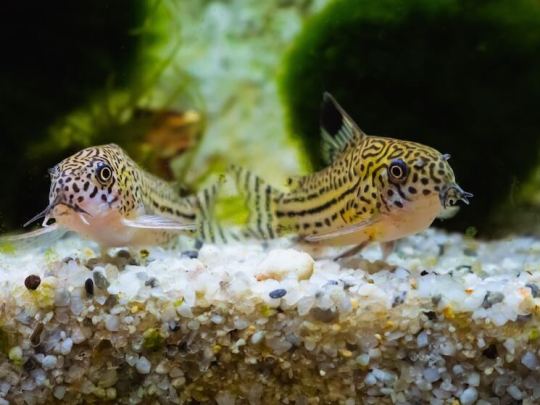#sterba's corydoras catfish
Explore tagged Tumblr posts
Text
Daily fish fact #732
Sterba's corydoras!

Like other corydoras catfish, these fish have a pretty unique way of reproducing: a male and a female will form a "T-shape", with the female's head resting between the pectoral fins and body of the male. The male releases some sperm, and the female moves it to her pelvic fins, which form a kind of "basket". The female Sterba's cory will then lay a single egg, places it in her pelvic fin basket, and swims off to place the now fertilised egg in a suitable safe spot. Then the cycle repeats until all eggs are fertilised!
#fish#fish facts#fishfact#biology#zoology#fishblr#cory cat#cory catfish#corydoras#corydoras catfish#sterba's cory#sterba's corydoras#sterba's corydoras catfish
60 notes
·
View notes
Text
Can you keep different Cory Catfish species together in one tank?

Introduction
Cory catfish, often referred to as "Corydoras," are a popular choice among aquarium enthusiasts for their charming personalities and unique appearance. These peaceful bottom-dwellers are known for their endearing behavior and are perfect for community tanks. However, when it comes to keeping different cory catfish species together in one tank, there are some important considerations to keep in mind. In this article, we will explore the various Cory catfish types and discuss the feasibility of keeping them together harmoniously in a single tank.
Click here to learn more :-
Understanding Cory Catfish Types
Before diving into the compatibility of different cory catfish species, it's essential to familiarize ourselves with the various types that exist within this group. Corydoras is a diverse genus, with over 170 recognized species. Each species has its own unique characteristics, including size, coloration, and behavior. Here are a few popular cory catfish types:
Corydoras aeneus (Bronze Cory)
Corydoras paleatus (Peppered Cory)
Corydoras sterbai (Sterba's Cory)
Corydoras panda (Panda Cory)
Corydoras habrosus (Salt and Pepper Cory)
Corydoras julii (Julii Cory)
Corydoras pygmaeus (Pygmy Cory)
Compatibility Considerations
While cory catfish are generally peaceful and sociable, it's important to consider a few factors when contemplating keeping different cory catfish species together in a single tank:
Tank Size: Cory catfish appreciate space to explore, and the size of your tank plays a crucial role in their compatibility. A larger tank allows for more fish and reduces the chances of territorial disputes.
Similar Water Parameters: Different cory catfish species may have varying preferences for water parameters like temperature, pH, and hardness. It's crucial to choose species that share similar requirements to ensure they thrive together.
Aggression Levels: Although cory catfish are typically non-aggressive, there can be instances of territorial behavior or competition for food. Mixing species with vastly different sizes or temperaments may lead to issues.
Group Size: Cory catfish are social creatures and thrive in groups. When mixing species, ensure that you have an adequate number of each type to prevent isolation or stress.
Compatibility with Tankmates: Consider the other fish species in your tank as well. Some species may be more compatible with certain cory catfish types than others. Avoid keeping aggressive or predatory fish with your cory catfish.
Potential Combinations
While it's generally recommended to keep cory catfish of the same species together, there are some combinations that can work successfully if you follow the compatibility guidelines:
Corydoras aeneus and Corydoras paleatus: These two species are relatively similar in size and temperament, making them a suitable pairing for a community tank. Ensure the tank is appropriately sized and provides plenty of hiding spots.
Corydoras panda and Corydoras habrosus: Both species are small and peaceful, making them great choices for a peaceful community tank with other small, non-aggressive fish.
Corydoras sterbai and Corydoras julii: These species have similar care requirements and can coexist peacefully. Ensure your tank is large enough and provide plenty of hiding places.
Corydoras pygmaeus and Corydoras habrosus: These tiny cory catfish types are excellent choices for small tanks. Their small size and peaceful nature make them ideal for micro-sized community setups.
Conclusion
While mixing different Cory catfish types species in one tank can be possible, it's essential to consider various factors to ensure a harmonious coexistence. Tank size, water parameters, aggression levels, group size, and compatibility with tankmates all play vital roles in determining the success of such a setup.
It's crucial to research the specific requirements of each cory catfish type you intend to keep and plan your tank accordingly. Always prioritize the well-being of your fish by providing appropriate hiding spots, maintaining stable water conditions, and monitoring their behavior closely. By taking these precautions, you can create a thriving and visually captivating community tank featuring a variety of cory catfish species.
Read more : - How do Indian Spitz dogs contribute to their families or communities in rural India?
0 notes
Video
Planted Community Tank by scubagolfa
1 note
·
View note
Video
Sterba’s Corydora | Corydoras sterbai
#sterba's#sterba#sterbas#corydora#cory#cory cat#cat#catfish#fish#freshwater#underwater#undersea#nature#fish tank#tank#planted tank#planted#Corydoras sterbai#aquarium#aquaria#aquascape#substrate#fisch
205 notes
·
View notes
